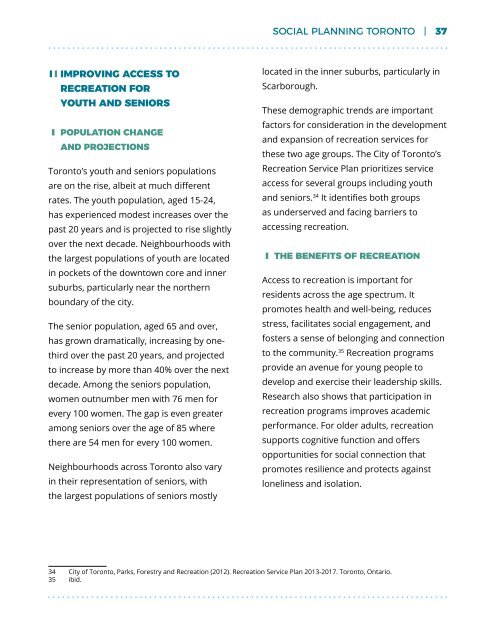Demographic Change in Toronto's Neighbourhoods
Create successful ePaper yourself
Turn your PDF publications into a flip-book with our unique Google optimized e-Paper software.
SOCIAL PLANNING TORONTO | 37<br />
IMPROVING ACCESS TO<br />
RECREATION FOR<br />
YOUTH AND SENIORS<br />
POPULATION CHANGE<br />
AND PROJECTIONS<br />
Toronto’s youth and seniors populations<br />
are on the rise, albeit at much different<br />
rates. The youth population, aged 15-24,<br />
has experienced modest <strong>in</strong>creases over the<br />
past 20 years and is projected to rise slightly<br />
over the next decade. <strong>Neighbourhoods</strong> with<br />
the largest populations of youth are located<br />
<strong>in</strong> pockets of the downtown core and <strong>in</strong>ner<br />
suburbs, particularly near the northern<br />
boundary of the city.<br />
The senior population, aged 65 and over,<br />
has grown dramatically, <strong>in</strong>creas<strong>in</strong>g by onethird<br />
over the past 20 years, and projected<br />
to <strong>in</strong>crease by more than 40% over the next<br />
decade. Among the seniors population,<br />
women outnumber men with 76 men for<br />
every 100 women. The gap is even greater<br />
among seniors over the age of 85 where<br />
there are 54 men for every 100 women.<br />
<strong>Neighbourhoods</strong> across Toronto also vary<br />
<strong>in</strong> their representation of seniors, with<br />
the largest populations of seniors mostly<br />
located <strong>in</strong> the <strong>in</strong>ner suburbs, particularly <strong>in</strong><br />
Scarborough.<br />
These demographic trends are important<br />
factors for consideration <strong>in</strong> the development<br />
and expansion of recreation services for<br />
these two age groups. The City of Toronto’s<br />
Recreation Service Plan prioritizes service<br />
access for several groups <strong>in</strong>clud<strong>in</strong>g youth<br />
and seniors. 34 It identifies both groups<br />
as underserved and fac<strong>in</strong>g barriers to<br />
access<strong>in</strong>g recreation.<br />
THE BENEFITS OF RECREATION<br />
Access to recreation is important for<br />
residents across the age spectrum. It<br />
promotes health and well-be<strong>in</strong>g, reduces<br />
stress, facilitates social engagement, and<br />
fosters a sense of belong<strong>in</strong>g and connection<br />
to the community. 35 Recreation programs<br />
provide an avenue for young people to<br />
develop and exercise their leadership skills.<br />
Research also shows that participation <strong>in</strong><br />
recreation programs improves academic<br />
performance. For older adults, recreation<br />
supports cognitive function and offers<br />
opportunities for social connection that<br />
promotes resilience and protects aga<strong>in</strong>st<br />
lonel<strong>in</strong>ess and isolation.<br />
34 City of Toronto, Parks, Forestry and Recreation (2012). Recreation Service Plan 2013-2017. Toronto, Ontario.<br />
35 ibid.
















